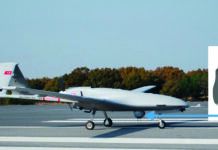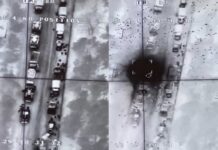The Second Nagorno-Karabakh War was fought between Armenia and Azerbaijan from
24 September to 10 November 2020. This 44-day war resulted in a decisive military victory
for Azerbaijan. Armenia was out-fought, out-numbered, out-spent and lost even though they controlled the high-ground in a mountainous region that favoured traditional defence. Azerbaijan’s alliance with Turkey, and close technological support from Israel, strategically isolated Armenia. In addition, Turkey’s posturing influenced the Russians not to intervene to support Armenia. That Azerbaijan attacked Armenia during the pandemic was an additional factor. The fact that Azerbaijan won the war is not extraordinary, considering the correlation of forces arrayed against Armenia. What is exceptional is that this was the first modern war primarily decided by unmanned weapons. In this war, the Turkish-made BAYRAKTAR TB2 Unmanned Air Combat Vehicle (UCAV) and the Israeli-made HAROP Loitering Munition (LM) dominated the fighting and provided Azerbaijan with a war-winning advantage. Here are ten lessons derived from a deep study of the open-source information about the conflict.
Know Yourself and Know Your Enemy
The First Nagorno-Karabakh War was a protracted conflict fought between 1988 to 1994. The war ended in Armenian victory and the occupation by Armenia of most of Nagorno-Karabakh. The Azerbaijanis did not want a repeat of that disaster. They researched their opponent, studied recent changes in the methods of war, adopted the latest weapons and proven tactics from Turkey’s experience in Syria and Libya, and trained their forces. Azerbaijan foresaw a niche advantage over their enemy and outspent Armenia six-to-one, investing more than US$24Bn in the decade before the war to purchase the latest Unmanned Aerial Vehicle (UAV), UCAV, and LM technology from Turkey and Israel. One of the primary lessons of the Second Nagorno-Karabakh War is to “know yourself and know your enemy,” and act on that knowledge.
Maintain the Initiative
Buying the best kit does not alone guarantee success in war. Training, organisation, and leadership are key. Turkey helped train Azerbaijani operators for their newly acquired Unmanned Aerial Systems (UAS) prior to the conflict. Armenia knew of this but did not react in time. Importantly, Azerbaijan had an effective plan, mobilised first, struck first, and then maintained the initiative throughout the war. The first to move in the three-dimensional game of chess that is modern war, and to integrate and synchronise fires and manoeuvre into a unifying concept, gains a tremendous advantage, and this is what Azerbaijan did. Armenia reacted to Azerbaijani moves from the first day of the war and never recovered.
Dominate as Many Domains as Possible
Azerbaijan fought in all five domains (land, sea, air, cyber and space), while Armenia fought in the land, air, and cyber domains. Azerbaijan used Turkish satellites and accessed commercial satellites for data transmission and information. Azerbaijan commanded the land, air, space and cyber domains for decisive moments during the first two weeks of the fighting to devastate Armenian air defences, which gave Azerbaijan air supremacy over Nagorno-Karabakh. From that moment on, the Azerbaijanis continued to fight in all domains to their advantage. The ability to see, decide, and engage in multiple domains, and dominate the ones that matter during decisive periods, is the essence of war in the 21st century.
Precision Fires Enable Manoeuvre and Manoeuvre Exploits the Effects of Fire
Fires have enabled manoeuvre in many wars, but the use of precision fires in this war was telling. The war was won by Azerbaijan with precision stand-off weapons, primarily UAS and artillery. Most of the casualties inflicted upon the Armenians were from TB2 UCAVs (approximate cost is US$3.5M) that launched smart micro-munitions, the HAROP “kamikaze” LMs (at a cost about US$70.000 each), and other UAVs that designated targets for UCAVs, LMs, and long-range artillery. Once Azerbaijan won air supremacy by destroying Armenian air defences using UCAVs and LMs, the Azerbaijanis then manoeuvred ground forces to occupy key terrain and critical objectives. The ground manoeuvre was often contested, and the Armenians inflicted casualties on the Azerbaijani ground forces, but most engagements were won by UCAVs, LMs, and UAVs spotting for artillery, before close-combat engagements occurred. Electronic Warfare (EW) “fires” also played an important role, to set the conditions for the UCAV and LM assaults, and there are reports that the Turkish KORAL EW system was used to prepare the battlespace prior to these attacks, as the Turks have demonstrated in combat operations in Syria and Libya. The Azerbaijani ground forces took several weeks to secure about 70 kilometres in the southern, lowlands of Nagorno-Karabakh, before turning north to take key terrain along the Lachin Corridor and the strategic town of Shusha. Throughout this effort, the Azerbaijanis method was to employ precision fires to enable ground force manoeuvre.
The Battlespace is Transparent
Azerbaijani sensors, mostly mounted on UAVs, gave the Azerbaijani military a clear, 24-hour, unblinking view of the battlespace. Armenian positions that were camouflaged in the traditional way were still identified by electro-optical and thermal cameras. Intelligence Surveillance and Reconnaissance (ISR) platforms were merged with strike capability in the forms of the TB2 and HAROP. High-definition, full-motion-real-time videos from these platforms provided ISR, destroyed systems and personnel, and provided accurate battle damage assessments (BDA). Although both sides had plenty of tanks, it appears that tanks seldom got within shooting range and most engagements were fought at stand-off distances. Combined arms can still be decisive, as air platforms cannot take and hold ground, but only if ground forces survive long enough to move within direct fire range. During the war, there were more standoff engagements, than close combat fights.
Masking
During the war, the Armenians could not hide. Physical camouflage was ineffective. One Armenian soldier said: “We cannot hide, and we cannot fight back.” Unable to mask from enemy sensors and precision strikes, the Armenians were demoralised. If camouflage is no longer enough, then a new concept of “masking” is required. Masking is the ability to become hard to detect and difficult to target. Masking involves a full spectrum effort to employ all active and passive means to confuse, disaggregate, disrupt, jam, and deceive the enemy’s sensors and targeting network. Masking will require new systems that minimise thermal and electronic signatures, requiring require new tactics, techniques, and procedures (TTP). In the modern battlespace, you either mask or die.
Top Attack is the Decisive Method of Engagement
The proliferation of affordable and effective top attack systems, as exemplified by the TB2 and HAROP, is a significant trend. It is no longer necessary to have a big cannon to penetrate the front glacis of a tank’s armour if you can destroy the tank with great accuracy from the top. Videos confirm that Azerbaijani top-attack UAS strikes destroyed as many as 185 Armenian tanks, 90 AFVs, 182 artillery guns, 73 multiple rocket launchers, 45 air defence systems and 450 other vehicles. The scale of these strikes by unmanned systems is stunning and unprecedented. In the long counterinsurgency wars of the past 20 years, insurgents attacked vehicles from the bottom with improvised explosive devices (IEDs). The IEDs now fly, and the top of an armoured vehicle is the Achilles heel of modern war.
Active Protection Systems and Air Defence
The war highlighted the requirement to defeat top-attack munitions. Most active protection systems, like the Israeli-made TROPHY system, do not protect armoured vehicles from top-attack munitions. To survive in this new environment, a layered, multi-capable, full-spectrum, air defence against top attack munitions, missiles, aircraft, and low-speed and high-speed threats, is vital. The lesson learned here is that future wars require a “spherical defensive system,” a mobile protective bubble. Active defence, to protect vehicles and personnel from underneath, lateral and top attack, will require new systems and will represent a significant investment by military forces. To survive, key platforms must be capable of disrupting, deflecting, or confusing incoming direct-fire and top attack munitions with either on-board systems or complimentary systems that accompany them. Many legacy systems, such as the M1 Tank, are already reaching their maximum weight and available surface area capacities. Additional systems, preferably unmanned systems, could provide this capability to legacy platforms to enhance survivability in the new multi-domain battlespace.
Win the Information War
Both sides waged an information campaign against the other, but the Azerbaijanis prevailed through their use of full-motion video footage from UAS and precision guided munitions. The images of Armenian air defence platforms, artillery, tanks, infantry fighting vehicles, and troops being decimated in these videos played on all available social media outlets. Many of Armenia’s Russian-made air defence systems were videoed with their radars spinning just before a HAROP or smart-micro munition blew the system to pieces. These videos showed how Armenia was losing the war and could do nothing to stop the Azerbaijani attacks, even when they were attempting to fight back. This footage influenced Armenia to surrender to Azerbaijan’s cease-fire terms and helped to deliver a decisive victory to Azerbaijan. These videos also became a successful marketing message and the TB2 UCAV and HAROP LM are now the hottest items on the international weapons market.
War Now Moves at Hyper-Speed and is More Connected than Ever Before
The pace of battle is now extremely fast. Engagements in the war were executed in real-time by multi-domain effects and battles were decided very quickly. Wars may still be long, as they are a test of human will, but a continuous chain of catastrophic engagements as experienced by the Armenians is demoralising and can destroy the will to fight. Using unmanned systems, the kill-chain accelerated. A kill-chain represents how an attack is structured and consists of target identification, dispatching a force to engage the target, deciding to attack the target, and then engaging the target. Most kill-chains today have a human performing the “decide to attack” function. As the Human-in-the-Loop (HITL) kill-chain transforms to an AI-leveraged Human-on-the-Loop (HOTL), or Human-out-of-the-Loop (HOOTL) kill-web, the speed of combat will quicken beyond human cognition and AI assistance will be required to control the fight and win.
The lessons of the Second Nagorno-Karabakh War represent a significant change in the methods of war. The use of UASs in this conflict, however, should be considered in context. Bad weather, effective air defence and Counter Unmanned Aerial Systems (CUAS) could have worked against the Azerbaijanis. As it turned out, the weather was good up until the last week of the war, the Armenian air defence was not effective against the Azerbaijani UAS onslaught, and the few Russian-made CUAS systems that the Armenians possessed proved ineffective. Nevertheless, the synchronisation of new weapons makes the modern battlefield more lethal and offers opportunities for a skilled opponent to use them to advantage. Most important for today’s military, this war has significance similar to the impact of the 1973 Yom Kippur War. The lessons of the 1973 War influenced the development of tactics and weaponry during the Cold War and beyond. For example, the US military conducted a thorough study of the Yom Kippur War, derived a new doctrine called AirLandBattle, and developed new systems, the “Big 5”:
- the M1 MBT,
- BRADLEY IFV,
- APACHE Helicopter
- BLACK HAWK Helicopter
- PATRIOT Air Defence System
These warfighting platforms, although significantly upgraded, remain the mainstay of the US Army’s striking power today. The methods of war, however, are changing and the recent fighting in the Caucasus provides insights for wars to come. As the first war won primarily with unmanned systems, we neglect the study of the Second Nagorno-Karabakh War at our own peril.
John Antal












